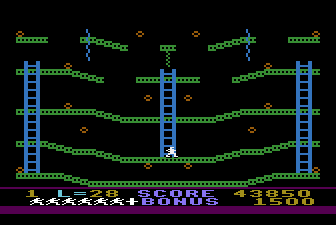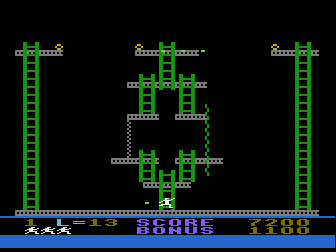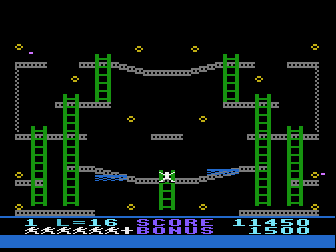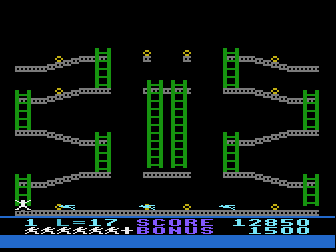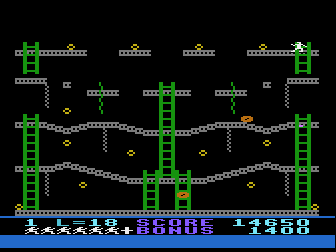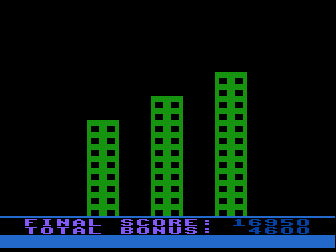Oo-Topos
is winnable now! Almost a week before I started playing it, a new copy
was put into the 4am collection at Archive.org. This version shows
"V0.1.2" on the title screen and fixes the bug that made the first
version unwinnable. If I'm not mistaken, it's a bit faster too, though
still pretty slow.
One
of the recurring problems in Oo-Topos is that certain actions will
trigger hostile enemies to pursue you forever until you find a way to
deal with them. Entering a gravcar area spawns a guard whose tenacity
basically made up for his lousy aim. Accumulating treasure spawns an
alien mummy who won't kill you, but will constantly and randomly show up
and take things from you. And on the beach where your ship lies in
pieces, there's an alien crab that follows you everywhere and eventually
kills you with a poisonous bite (Mike, crabs don't bite, they pinch,
and poison is ingested).
Previously,
an encounter with the "tras" at the bottom of a deep bit showed me that
combat is pretty random, and not necessarily in your favor. The needler
weapon that I found there proved to be its doom, but luck alone, as far
as I could tell, determined whether I would kill it before it killed
me. This non-determinism not only makes finding these solutions
unsatisfying, but also violates an unwritten rule of trust. My weapons
had failed to kill before - does that mean I was using the wrong
approach, or that I was unlucky? Adventure was guilty of this with its
dwarves, but this only happened with the dwarves, and your attacks
usually worked. Zork was okay about this because the encounter with the
troll was so lopsided in your favor and yet dynamic enough to teach you
that combat has a random element. But here, it's just worrying, and I
felt compelled to rely much on saving/loading to retry.
The
rule here, which is only known to me in retrospect, is that these
enemies are killed with their own weapons. And after you do, the weapons
serve no other purpose. The alien near the start is killed with his own
laser gun, and this always works. The tras at the bottom of the pit is
killed with the needler found there. On the same note, crabbette by your
ship sometimes tosses a pouch of poison right at you. You just pick it
up and type "kill crabbette" until it works.
The encounter with the alien by the gravcar was ridiculous.
So
first of all, the intended solution is, once again, to kill the alien
with its own weapon. If you don't have the dart that it initially throws
at you, then your attack will fail and it will take away your laser or
needler. If you do have it, then "kill guard" is specific enough.
But
the text says that he vanishes. This is wrong - you can attack right
away, though you must specify "guard." Typing "kill alien" or "shoot
alien" produces the message "I DON'T SEE ANY ALIEN HERE," which I found
pretty confusing until I realized the game expected a different noun.
Missing with the dart does not remove it for your inventory for some
reason - are we just stabbing with the dart or something?
Back
at the bottom of the pit where I killed a tras with a needler, a cold
door went east to a cold storage room. No problem here - an ice-covered
chest sat here instead of an ice-covered box.
 |
| In the first version this is as far as you go. |
Opening while wearing gloves reveals the serum, which is not spoiled by removal from its temperature-controlled environment
I
began the tedious process of collecting everything I could and bringing
it back to the ship. Most of these items, I figured, were either cargo
or needed for repairing the ship, and it would be handy to have a
staging ground for the rest of these items, even if the ship was quite
far away from all the action. I'd try to solve what puzzles I could
while doing this, but the focus would be on consolidating everything.
There's
a six-item inventory limit, effectively five since much of the game is
set in darkness where you can't survive without the light rod, making
the constant trekking back and forth pretty time consuming even with the
magic word shortcuts. Making it even worse, the game has a tendency to
randomly pause for several seconds after entering commands, and there
doesn't seem to be any pattern to it. It's not always accessing the disk
either, though it does that a lot too.
In
the upper floor of the prison, a pair of goggles outside the trapped
alcove claimed to allow me to "see all" when worn, but I could not walk
while wearing them. So I went into the alcove, where the door slammed
shut behind me, and when I wore the goggles and looked, I saw a
vibroaxe, which I used to chop my way back out. In this area I also
found a 4-D mirror and a phase-matter shifter that could be taken while
wearing gloves. These had interesting descriptions - the 4-D mirror said
it revealed my past, present, and future, and the shifter said "to
phase in matter shake well." I couldn't find a use for the mirror, but
the shifter when shaken on the roof caused a ramp down to the jungle to
materialize, significantly shortening the trip back to the ship.
During
my next trip I collected the ship's energy converter, a library crystal
(containing all human knowledge), and a betamax, the last of which
attracted the alien mummy's attention, who took both the crystal and the
betamax. A field nullifier found in the hydroponic garden maze opens up
a fairly unnecessary shortcut between the white room and the tunnel
west of the garden, and the ship's water purifying system is found
nearby it. On the way back to the ship I picked up a piece of cloth and a
plasma sphere that had been gifted to earth from the council - these
too were taken by the mummy. In their place I hauled back a seamless,
unopenable box, and the ship's repair manual.
Returning
to the fly room and jungle I recovered some more precious cargo for
earth - a PSI cube, elixer (sic) of youth, double helix repairer, an
emerald flower, an atom transmuter, a 6502 processor and some
miscellaneous relics that had been on loan to the council. All were
taken by the mummy. Here, I also recovered the ship's navigation chip
from a dangerous life form by feeding it seeds found nearby. On the way
back I took the last few loose items - a harmonica, a bag of diamond
dewdrops, a jade seahorse, and ruby seashell.
At this point, only a few known problems remained unsolved.
- How do you get the universal translator from the robot?
- How do you get past the forcefield near the gravcar?
- How do you get the gyro from the creature in the ampitheater?
- How do you get past the apparition in the flickering corridor?
- How do you open the seamless box?
- What do you do about the alien mummy? And can the treasures be recovered?
- How do you fix the ship?
On
that last problem, I found the game did not recognize the words
"repair" or "fix," but responded to "build ship" with "I can't do that
yet," which may indicate it didn't understand my request, or that I
indeed can do that later, but not until I have more parts. If the
latter, then there's no indication at all on what parts are needed.
"Read manual," bizarrely, produces "I can't read the manual." I'd
revisit this later when I had more parts.
I
tried chopping the seamless box with my axe, but was told you couldn't.
Opening it gave the message "It would be a lot easier if I could find a
seam," so I tried wearing the goggles, and then it opened easily,
revealing a compass from the ship's nav system inside, as if that was
useful in space.
I
tried seeing if the goggles would help me get past the apparition
somehow, as it seemed to phase in and out of reality. They did not. They
did, however, allow me to spot a jewel in a nearby room with blinding
strobe lights.
I
examined the unused items, and noted that the flask was acid-proof and
also etched with inscrutable markings. Returning near the start, I found
that if I emptied the flask and filled it with acid from the nearby
room (hope the flask didn't have anything important in it!), I could
kill the robot by pouring acid on it and take the translator. This did
not allow me to read the writing on the flask, but I could read the
plaque in the gravcar, and after doing this (it just said "good for
one-way trip NE"), I found I could travel northeast through the force
fields to the tunnels - yet another shortcut that I didn't especially
need.
Reviewing
my stock of items, I found that I had yet to find a use for the caged
snarl ("its lungs can expand exponentially" reveals the game when it is
examined), or any use for the vibroaxe except to escape from the room
where I found it, so I took both to see if either could help me with my
outstanding problems. I found no further use for the axe, but dropping
the snarl in the room with the gyro caused it to sit in the large
creature's mouth, and I got the gyro.
I
soon discovered that you could fill the flask with water from the pool,
and pour it on the apparition to kill it. The door to its north
contained all the treasures it had stolen, and the door to its south had
a 4-D wrench that phased out of existence when touched, and another
magic word - TAKA<->LEVA - giving a convenient shortcut back to
the beach. Wearing the goggles allowed me to take the wrench, and I
brought the rest of the valuables back to my ship in short order.
My
hunch about the "BUILD" command was right. It works, but you must be
holding the wrench and manual, and these items must be on the ground in
front of you:
- Tachyon-power cylinder
- Stabilizing gyro
- Compass
- Navigation chip
- Oxygen recirculator
- Water system
- Energy converter
My
ship finished, I underwent the tedious process of moving my 40-odd item
collection into the hold, six items at a time, and then went up to the
bridge and took off by heading "up" once more.
One
last job to do. I retrieved everything from the hold again, six items
at a time, dropping them onto the bulkhead floor. I typed "score" and it
said I had 130 points, over 611 turns, with no fanfare or
acknowledgement that I had found or done everything. After a brief
review of the code I concluded there wasn't any, so I didn't bother
playing any longer to determine if I had missed anything. I'm satisfied
that this is the only closure that you get. In fact, you can "win" by
returning without anything, not even the serum. The only difference in
acknowledgement would be your lower score.
I did put together how the scoring system works. First of all, there are 46 points scored by completing certain actions:
- Shoot alien with laser: 2 points
- Shoot tras with needler: 2 points
- Kill crabbette with pouch: 2 points
- Kill guard with dart: 2 points
- Chop partition with axe: 4 points
- Shake shifter on roof: 4 points
- Feed huja with seeds: 4 points
- Pour flask of acid on robot: 4 points
- Read plaque with translator: 4 points
- Drop snarl near creature: 4 points
- Pour flask of water on apparition: 4 points
- Build ship: 10 points
The
rest of the points are from recovering inventory items. I had 42 items,
and each is worth 2 points when brought to the floor of the loading
bay. Prior to this, you'll get 2 points for each treasure in your
inventory, and 1 point for each non-treasure in your inventory.
Delivering all 42 items (not counting the seven needed to repair your
ship) is worth 84 points, for a total of 130, unless I'm missing
something.
My
final Trizbort map had 141 rooms, making it a bit bigger than Colossal
Cave Adventure, and certainly the largest BASIC adventure game that I've
played yet.
GAB rating: Average. Jason Dyer describes this as a sci-fi version of adventure,
and this seems about right. I enjoyed the exploration aspect when I
wasn't stuck in mazes, but sweet Xenu does this game overdo it on the
mazes, with five boring MOTLP mazes that all but mandate mapping out with spreadsheets and item breadcrumbs.
To
Oo-Topos' credit, I enjoyed its writing more than I enjoyed
Adventure's. Its best feature is that most of the items give amusing
little descriptions or anecdotes when examined, which is a feature we
take for granted now, but was far from universal in 1981. Even Zork
didn't have this as consistently. And apart from the lame luck-based
combat puzzles, where three times you need to kill an enemy with the
very weapon it throws at your feet and the fourth time you kill it with a
weapon that's already there, the puzzles are pretty alright. They're a
bit easy and I solved the game without external help (other than Dyers'
warning), but with a simple BASIC engine you're not going to get
terribly sophisticated puzzles anyway, and figuring out what to do
through intuition, process of elimination, or deducing the meaning of a
clue in an item description was pretty satisfying.
I
did not enjoy the mazes, the tedious item hauling in the endgame, or
how it doesn't acknowledge when you're done, and got irritated by a
number of previously mentioned failings. In the end, Oo-Topos is more
interesting than Adventure, but also more flawed, and ultimately I can't
say it's better or worse than that ur-Adventure it so closely models.
My final map:


















